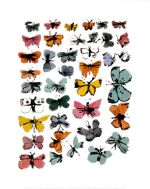
|
||
|
|
|
|
| Forgot Password | ||
Butterfly Facts
Posted by MariaBBB |
Added on : May 07, 2010 01:30am |
Viewed 3855 times
| 0 Comments | This article is also in butterflies
and butterflies
According to popular belief, the word butterfly is derived from the expression "butter-coloured fly", a term which may have been applied to the Brimstone - one of Britain's most well known insects, and often the first butterfly to be seen when the adults awake from hibernation in early Spring.
 There may however be more truth in another explanation. In Old English the word was spelt "butterfloege". In Old Dutch and German it was "botervleig" and "butterfliege" respectively. All of these translate as "butter fly". Another German name "milchdieb" translates as "milk-thief" and probably refers to the habit that these insects have of being attracted to the aroma of buttermilk. In areas of eastern Europe where ancient farming methods are still practiced butterflies of various species are sometimes attracted to buttermilk being hand-churned in farmyards. Could this explain the origin of the word butterfly ?
There may however be more truth in another explanation. In Old English the word was spelt "butterfloege". In Old Dutch and German it was "botervleig" and "butterfliege" respectively. All of these translate as "butter fly". Another German name "milchdieb" translates as "milk-thief" and probably refers to the habit that these insects have of being attracted to the aroma of buttermilk. In areas of eastern Europe where ancient farming methods are still practiced butterflies of various species are sometimes attracted to buttermilk being hand-churned in farmyards. Could this explain the origin of the word butterfly ?
The average lifespan of an adult butterfly is about 2 weeks, but some species ( e.g. Heliconius erato and Taygetis mermeria from South America, and Gonepteryx rhamni from Europe ) can live for at least 11 months.
The whole lifecycle from egg to adult takes about 3 weeks to complete in many tropical species. Intemperate regions however there are usually only 1 or 2 generations a year, while in the sub-arctic tundra several species take 2 full years to complete their lifecycles.
According to popular belief, the word butterfly is derived from the expression "butter-coloured fly", a term which may have been applied to the Brimstone - one of Britain's most well known insects, and often the first butterfly to be seen when the adults awake from hibernation in early Spring.
 There may however be more truth in another explanation. In Old English the word was spelt "butterfloege". In Old Dutch and German it was "botervleig" and "butterfliege" respectively. All of these translate as "butter fly". Another German name "milchdieb" translates as "milk-thief" and probably refers to the habit that these insects have of being attracted to the aroma of buttermilk. In areas of eastern Europe where ancient farming methods are still practiced butterflies of various species are sometimes attracted to buttermilk being hand-churned in farmyards. Could this explain the origin of the word butterfly ?
There may however be more truth in another explanation. In Old English the word was spelt "butterfloege". In Old Dutch and German it was "botervleig" and "butterfliege" respectively. All of these translate as "butter fly". Another German name "milchdieb" translates as "milk-thief" and probably refers to the habit that these insects have of being attracted to the aroma of buttermilk. In areas of eastern Europe where ancient farming methods are still practiced butterflies of various species are sometimes attracted to buttermilk being hand-churned in farmyards. Could this explain the origin of the word butterfly ?
The Barcode of Life Project estimates that 1.7 million species of animal are currently known to science, of which 253,680 are butterflies or moths.
In "Butterflies of
Since then many more species have been discovered, and many species previously listed as sub-species have been elevated to full species status. In 2007 Adrian Hoskins collated data from a number of sources and produced a World Butterfly Census which enumerates 17657 currently known species.
The true total will never be known, as many species will become extinct before they are discovered, but is likely to be in the region of 18,000 - 21,000 species.
In many species there are obvious visual differences between male and female butterflies. The Polyommatinae ( Blues ) for example usually have blue males and brown females. The males of Hairstreaks, Satyrines, large Fritillaries and Skippers often have androconia ( scent emitting scales ) in the form of dark patches or streaks on the upperside forewings.
The differences in other species may be more subtle - males generally have more angular wings, longer thinner bodies, brighter colours, and stronger patterns than females of the same species. There are usually obvious differences in behaviour as well - males tend to actively patrol their habitats, or to establish a small territory which they defend against other butterflies. Females by comparison are far more sedentary, and in the early part of their flight period tend to stay in areas where both adult and larval food sources are present.
There are several very widespread species including the Monarch Danaus plexippus, the Plain TigerDanaus chrysippus, the Long-tailed Blue Lampides boeticus, and the Small White Pieris rapae, all of which are found on at least 3 continents.
The Painted Lady Vanessa cardui however is the most widely distributed butterfly in the world, found in North America from
The cosmopolitan distribution of the Painted Lady is caused by a combination of it's very strong migratory behaviour and polyphagous nature - in Britain its caterpillars feed almost exclusively on thistles, but elsewhere they utilise a vast range of foodplants amongst the Compositae, Malvaceae,Boraginaceae, Hydrophyllaceea, Ulmaceae, Rutaceae, Chenopodiaceae, Convolvulaceae, Labiatae,Plantaginaceae, Leguminosae, Urticaceae, Verbenaceae, Cucurbitaceae, Cruciferae, Umbelliferae, Rosaceae, Rhamnaceae, and even one or two grasses.



Be the first one to comment on this article